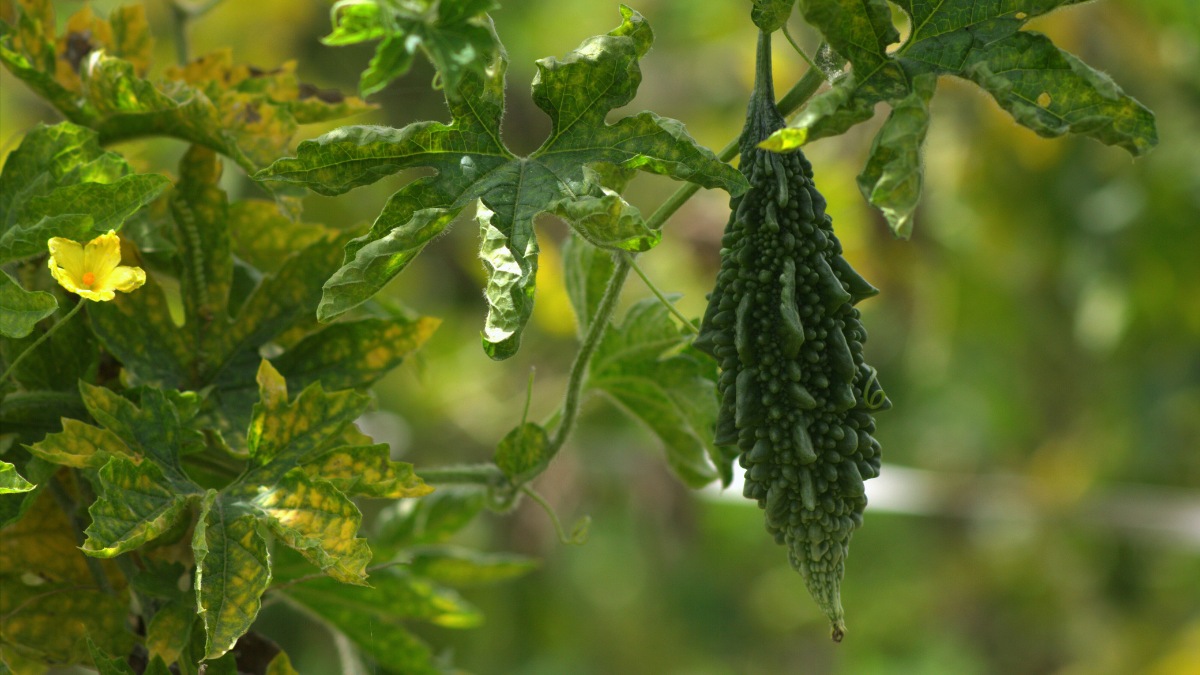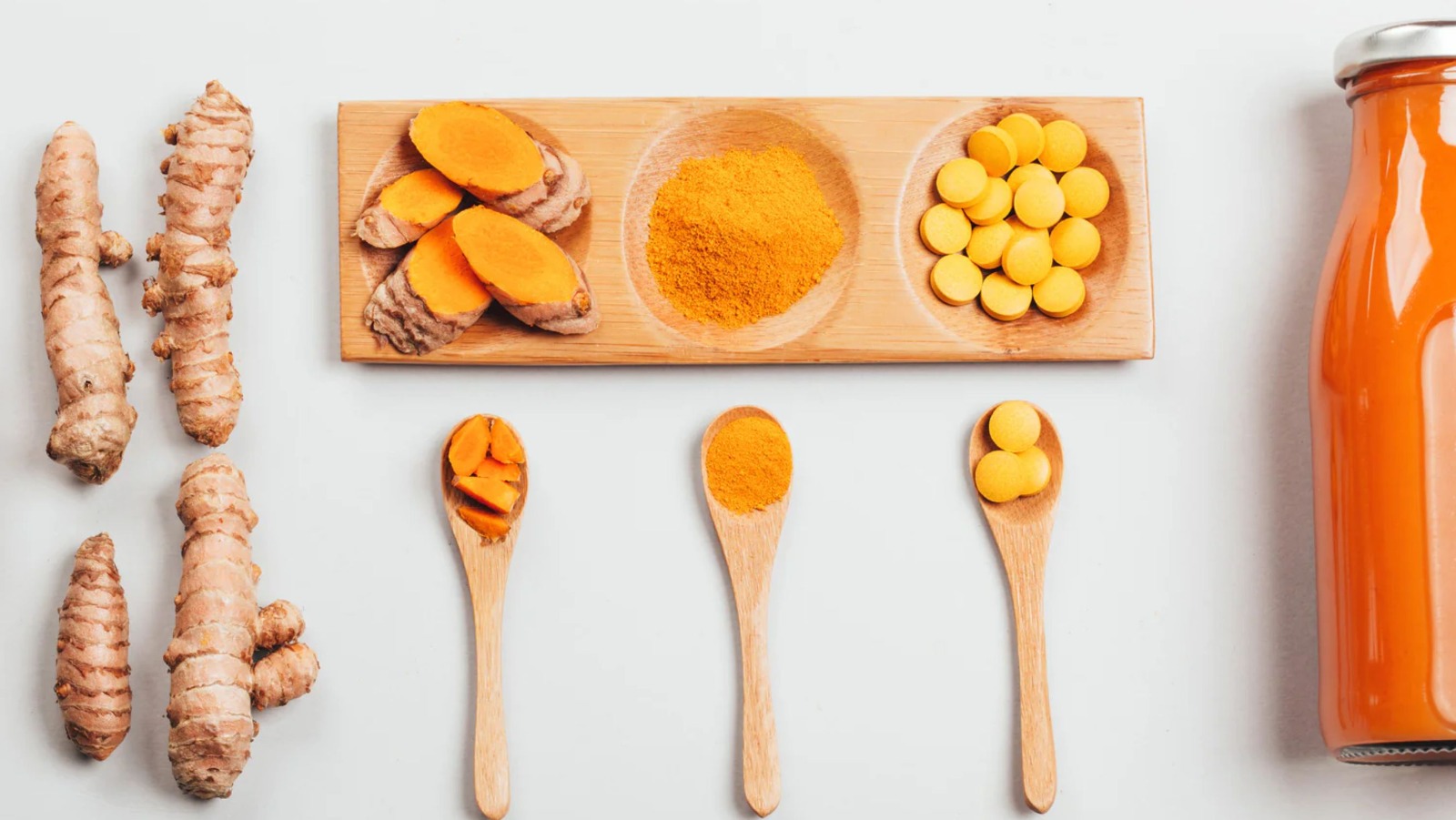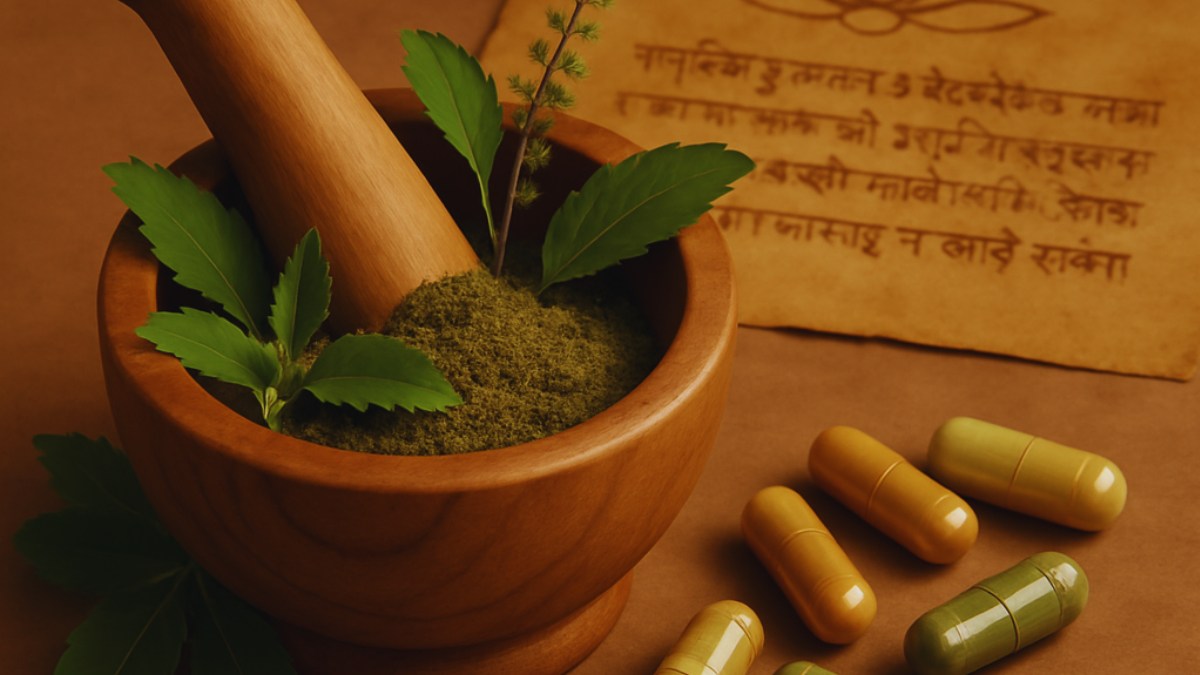Bitter melon is characterized by its deeply lobed leaves and long, warty, cucumber-like fruit, which starts green and turns yellow-orange when ripe. The fruit’s distinctive, bitter flavor is one of its most notable features. The plant bears male and female flowers, and its fruit contains seeds that are embedded in a fleshy, bitter pulp. Its vines can grow up to 5 meters long, making it a common fixture in gardens and farms across the regions where it is cultivated.
As you might have guessed, the Bitter Melon is bitter! Yet this has not stopped it from being used widely in cuisine—it is consumed raw or cooked, and sometimes soaked to reduce bitterness, both in the green or yellowing stage. The young plant shoots are also sometimes consumed.

The traditional consumption of Bitter Melon as part of the diet is widespread and has a long tradition for use in bringing health benefits–to support balance blood sugar, the liver and pancreas, and support cleansing the blood and circulatory system.
KP Phyto has invested heavily in understanding the points along the supply chain that must be controlled for the best quality outcomes in Bitter Melon ingredient quality. We also invest into the understanding and development of the research behind Indian traditional botanicals…with a focus this month on Bitter Melon!
A Traditional Bitter
Bitter melon is one of the quintessential examples of a dietary bitter, widely consumed to promote digestive health and metabolic efficiency. In many culinary traditions, particularly in Asia, Bitter Melon is incorporated into meals to stimulate digestion, support liver function, and detoxify the body. The bitter taste is known to activate receptors in the gut that trigger digestive secretions, bile production, and enzyme release, which collectively improve the body’s ability to break down food and absorb nutrients.
In Ayurvedic diets, Bitter Melon is often included in seasonal detox routines to clear excess heat and Kapha, stimulating the digestive fire and supporting overall metabolic function. The fruit can be prepared in various ways: stir-fried, stewed, or juiced. In some cultures, bitter melon is pickled or stuffed to create a unique flavor profile that still retains its bitterness.
In China this bitterness is appreciated in a wide variety of dishes, as well as in beer in the place of hops! It is similarly enjoyed in cuisines of several Asian countries, India, as well as in Africa and the Caribbean.

In Ayurveda
In Ayurveda, Bitter Melon, also known as Karela, is revered for its potent bitter taste, which is linked to its ability to balance Kapha and Pitta doshas. Ayurveda associates bitterness with stimulating digestive fire (Agni), clearing toxins (Ama) from the body, and purifying the blood. Bitter melon is classified as having tikta rasa (bitter taste), which is beneficial for improving appetite, digestion, and metabolism. In Ayurveda, even though it is characterized by a bitter flavor, and thus a signal that it balances Kapha and Pita doshas, Bitter Melon is actually considered tridoshic—good for balancing all three doshas.
Bitter melon is commonly used for blood sugar balance, as Ayurvedic practitioners believe it has the ability to regulate blood sugar by reducing excess Kapha, which is linked to obesity and sluggish metabolism. Additionally, it is used in formulations for skin health, digestive support, and respiratory wellness, and is considered to have rejuvenating (rasayana) qualities that support the immune system.
The Chemistry
There are several compounds that have been identified as possibly being main actives, including a polypeptide dubbed “plant insulin”, polypeptide P, or p-insulin. Other important compounds are present including charantin, a mixture of two steroid glycosides, which is believed to play a role in blood sugar balance. Vicine is a glycoside present that also has been found to support blood sugar balance.
Other bioactives include the cucurbitacins, bitter compounds with liver and other wellness supporting activies; as well as, saponins and flavonoids, both known antioxidants that can balance oxidative stress in the body. Bitter Melon also contains a good amount of vitamins A, C, and several B vitamins, along with as minerals such as potassium, magnesium, iron, and zinc.

The Science
The fruit, seed and leaf extracts of Bitter Melon have demonstrated blood sugar balancing activities in preclinical studies. Within 30-60 minutes, p-insulin has been observed to have similar effects to bovine insulin, which peak at about 4 hours.
Research has suggested that Bitter Melon may stimulate the production of GLP-1 (glucagon-like peptide-1), a hormone that plays a crucial role in regulating appetite and insulin secretion.
Bitter Melon’s role in activating AMPK (AMP-activated protein kinase), a key regulator of energy metabolism, has been investigated for its potential to support a healthy weight.
Bitter Melon has been observed to decrease gluconeogenesis in the liver, while increasing glycogen synthesis, as well as increasing the secretion of insulin from the pancreas. There are also observed effects in the muscles: increased content of insulin-regulated glucose transporter (GLUT4) and glucose uptake.
Bitter melon’s rich content of flavonoids, saponins, and cucurbitacins contribute to its cytokine balancing and antioxidant properties. These compounds help balance oxidative stress that is important for maintaining a state of health.
Despite the promising possible mechanisms of action and preclinical research, not all clinical evidence has shown clear benefit—while some studies have found improvements in HbA1c and fasting glucose, others found no significant difference. Therefore, more studies are needed to understand its wide clinical use.
Looking into the Future
Bitter Melon is a plant with multiple uses and a long history of use in traditional medicine systems. The research has been building behind its diverse range of bioactive compounds, particularly its insulin-like peptides and bitter triterpenoids, which contribute to its efficacy in supporting blood sugar balance, supporting digestion, and promoting overall health. Although more clinical studies are needed to better understand how it is best used for health, there has been some good advances in substantiating its traditional use. Whether consumed as a bitter tonic, a dietary staple, or a traditional medicine, bitter melon continues to be valued for its multifaceted health benefits.
Thank you for Reading!
*This content is for informational and educational purposes only. It is not intended to provide medical advice or to take the place of such advice or treatment from a personal physician.







